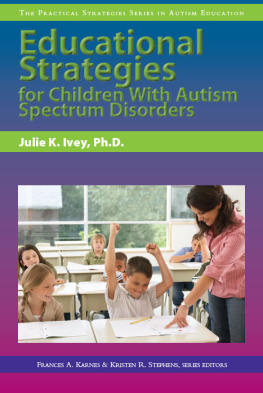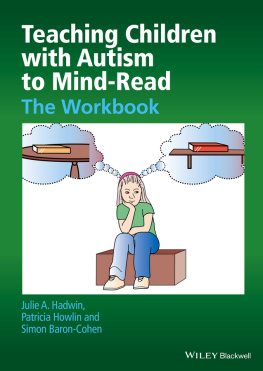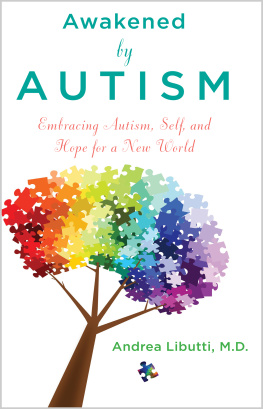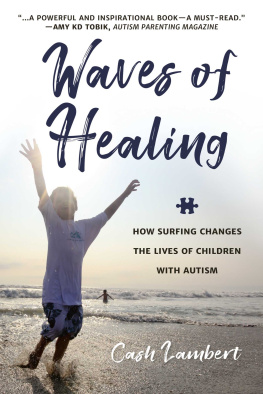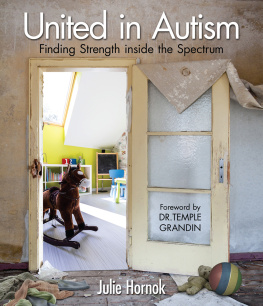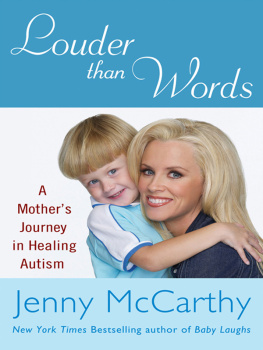Acknowledgements
I have been working on this book in one way or another for seven years. Every step of the way, information and people I needed seemed to unfold before me. In my opinion, a true sign of what was meant to be.
The angel Im most grateful for is Anita Kugelstadt, my editor, and the mom of a child with autism who offered me her editing services with nothing expected in returnsimply the desire to help other parents by helping me get this work out there. Anita made sure that the book was readable. She lent a critical eye that could ensure it was scientifically sound and referenced for accuracy for professionals interested in the science. But most importantly she shared her experience as a parenton this path for a whilewho was able to remember her first experience with all of this information, enabling me to provide clear answers to the questions asked by parents new to biomedical. She also ensured that I included information for non-responders and more complex situations, so that this book could help parents anywhere along the road new parents, children that responded quickly to simply interventions, and nuances for those who have been working with diet for years. Anitas perspective, knowledge, and hard work were helpful beyond words.
This heart and spirit of Anita, I see reflected in many. And I am so grateful for everyone who offered assistance. Trudy Scott, CN (Certified Nutritionist), my research assistant, spent many days helping gather crucial scientific references. Her knowledge of nutrition, project management ability and interest in the subject, were essential. She worked long, hard hours pulling the final pieces of this book together, and again, she asked for nothing in return. I could not have done it without her.
There were also several wonderful women who lent their passion and knowledge out of the kindness of their hearts. Kelli Pallett, who initially offered to edit for me, then later invited me to speak to parents in Toronto. Unknown friends responded to my email, offering to help me as I pulled together many more pieces of research. I genuinely appreciate their efforts. Thank you Marjie, Bonnie, Wendy, Cynthia, Kerry, and Nicole.
All of these women have demonstrated what I love so much about the autism communitywe are a family. We are all on the same team. We are here to support each other. The love, commitment, and strength of these mothers, fathers, and professionals are so powerful that I am often brought to tears. This is a labor of love for me.
I thank all of the parentsknown and unknown. You provide me strength in my own life to face the trials and tribulations that affect us all as humans through your unending hope, faith, and perseverance. Your knowledge is often greater than mineI am humbled by it, and I learn so much from you all.
Thank you to all the clinicians and scientists who have stood up for the truthoften at great risk to their own livelihood. You are true heroes.
Finally, to my husband, my greatest support, who believes in me more than I believe in myself at times. You have supported me physically and emotionally when the pressure felt too much. You encouraged me to follow my passion and do what I felt was right - regardless of what others said I should do. Your unconditional love has allowed me to become my complete self. With you by my side, I can create freely and share openly.
Though I do not have a child on the autism spectrum, I was drawn to help from the first day I learned the biochemistry of autism. Something in my heart told me this was right and I became driven to share so that others may benefit from applying nutrition and diet toward healing and wellness. My passion to continue learning stems from my commitment to seek answers and identify solutions.
Julie Matthews is not a physician. She does not diagnose or treat disease. This book is not intended to replace a one-on-one relationship with a qualified health-care professional, and is not intended to provide medical advice.For medical advice, always seek a physician. This book is solely intended as a sharing of knowledge and information based upon the experience and research of the author.

""
Table of Contents
HOW TO READ THIS BOOK
Ive intended for this book to be an informational resource, how-to guide, trusted reference, and workbook. In addition to gaining knowledge that will help you be the best advocate for your child, this book is a manual from which you can start helping right away while you determine questions you should ask your physician. Your nutrition approach for your child will evolve and change over time and as you return to this book, it will function as a great resource guide. Ive included blank diet records, charts and lists you can copy and fill out or post on your refrigerator for reference.
This book will lay a foundation of knowledge, and then will take the reader on a tour of ideas that will be revisited again and againoften from different angles, or with fresh information. These concepts are complex and important, so I will be sharing them in small bite-sized pieces many times. You may also find it helpful to go back and reread sections. Each section is self-contained though builds from the previous section. Because of that, its best to read this book from beginning to end the first time. After that, you can go back and skip around in any order.
If there is any information you find too complex, just read through it gaining as much information as you can. There have been many times in my studies that I read and listened to speakers four, five, or six times. Its amazing how much you will pick up by re-reading the information. When you return to it over time, you will have additional knowledge and a maturing perspective from which to see the information in a new light. If you prefer however, skip a section and come back to it later.
The book is referenced with parentheses and a bibliography versus endnotes. While I realize endnotes are more accepted in scientific texts, I prefer to view a list of all studies in order alphabetically by last name. This way I can look up a study by a particular researcher without having to know what page they are on. Thus, I have chosen to annotate the book this way.
Throughout the book I mention children with autism. This is because most parents begin their search for answers when their child is diagnosed; however, this book is for anyone on the autistic spectrum, including adults. Also, please note that while the sooner you intervene the quicker youll see a response; this does not mean that older children and adults do not benefit. Anyone can benefit from nutritional intervention at any point in time.
I will be using the terms autism, autism spectrum disorders, and autistic spectrum disorder (ASD). Included within ASD are: autism, Aspergers Syndrome, low and high-functioning autism, PDD:NOS (Pervasive Developmental Disorder: Not Otherwise Specified), as well as ADHD (Attention Deficit Hyperactivity Disorder). Many do not want to think that ADHD is on the autism spectrum because of the stigma associated. I feel that only if we understand how these disorders are related and acknowledge the truth of the emerging information on this subject, can we do our best to help these children. As you read through this book, if you are interested in ADHD, please understand that what applies to ASD also applies to ADHD.

![Julie Matthews Nourishing Hope for Autism: Nutrition and Diet Guide for Healing Our Children [Perfect Paperback]](/uploads/posts/book/100368/thumbs/julie-matthews-nourishing-hope-for-autism.jpg)
